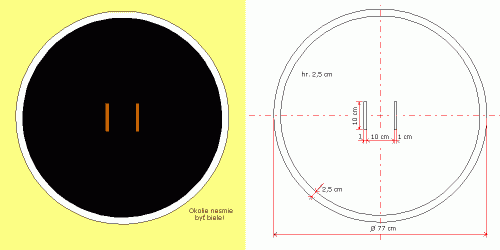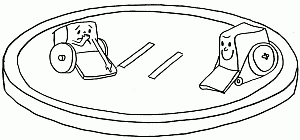
This is an unofficial translation of the rules. The only official version of the rules in cases of misunderstanding is the Slovak version.
MiniSumo category
Introduction
Two self-controlled robots are placed in a ring. The robots try to avoid falling out or avoid being pushed out by the opponent robot. The first robot that touches outside of the ring loses the round. Different robots compete one-on-one against each other throughout the contest. The robot that wins the most matches wins the contest.The Ring
The Robot Sumo ring is a flat disc where robots are to compete.
The top surface is dull black, except for a thin border that is shiny white. Two starting lines in the middle are brown. The ring surface should be as flat as possible to not influence robots movement.
The dimensions of the ring are on the following picture:
| Diameter | Height | Width of the white margin | Width of the start line | Length of the start line | Distance of the start line from the center |
| 77 cm | 2,5 cm | 2,5 cm | 1 cm | 10 cm | 5 cm |
An external area of at least 100 centimeters (3.3 feet) of empty space exists around the ring. This space must not contain any people, objects, lights, or anything else that would distract or interfere with the robots. The floor may be any color but white.
Robots
Mass

Mini-class Sumo robots may have a mass of 500 grams (1.1 pounds) or less.
Lift can't reduce the robot below the required limit because the limit is specified in mass (universal constant) rather than weight (gravity component). For example, a helium-filled balloon can't be used to lighten a robot during weigh in.
Because this is a pushing contest, it is to the robot's advantage to be as heavy as possible. Many builders bring extra weights or washers to increase the robot's mass to the maximum amount as measured at the contest location.
Dimensions
At the start of each round, Sumo robots must not exceed a specified width and depth. Mini-class Sumo robots may be 10 centimeters (3.93 inches) or less in width and 10 centimeters (3.93 inches) or less in depth. There is no height limit.

Also, as soon as movement is allowed in a round, the robot may then twist, fall, or expand without size limits.
The lack of a height limit is important to some builders, as they may stack up electronics, motors, and other parts that wouldn't otherwise fit. The lack of a height limit combined with the ability to change orientation during a round provides for creative opportunities. Crafty inventors build tall scoops atop their robots. The robots then fall down to make themselves longer than would be initially allowed.
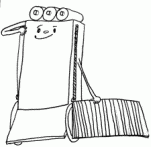

The competition and the order of the competitors
Inspection
Each robot is measured and inspected to verify qualification. To avoid arguments over analog needle interpretation, usually a digital scale is used for determining mass. For width and depth, a carefully measured box or cube is placed over the robot. Actually, the box is more of a tube really, because it is missing the top and bottom. The box avoids arguments over ruler interpretation, because the robot qualifies if the robot fits in the box. The robot must start each round of the contest in an orientation and physical position that would fit in the box. It would be unfair to measure the robot in one position (sticking out of the top of the box) but then manually rotate the robot to an unqualified length before beginning a match. The robot is inspected to be sure it is non-damaging and generally safe.
Acceptance
Robots may be altered between rounds and matches, either for repairs, battery changes, or reconfiguration.Playoffs
Depending on how many robots participate, the organizers can choose a number of different elimination methodologies. A few popular methods are presented here, but obviously creative variations can be designed to meet the needs of a particular contest.
Single Elimination: Upon losing a match, the robot is out of the contest. This is the harshest method and least likely to convincingly determine winners. It also means half the participants get to compete only once.
Round Robin: Each robot faces each other robot (one at a time) in a match. Although this can take a long time, it is the most fun because every robot gets a chance to compete against every robot. This method also has the advantage of determining all robots' actual rank, not just a sole winner.
Heats: The robots are divided into smaller groups and a method above is used within each group to organize one-on-one matches. The winners of each group advance.
A Match
The robot must be ready at the appointed times. Contest organizers may grant reasonable leeway, but a referee may declare a round or entire match lost if a robot isn't punctually prepared to compete.
Throughout the contest, the algorithms, settings, and components on the robot can be shaped, angled, or configured differently for facing each opponent and being placed in different starting positions.
Positioning

The better-ranked robot or the robot that just won the prior round is positioned first.
The contestant may place his or her robot in any position, angle, or location on the ring except that no portion of the robot may cross the extended starting line nearest the contestant. The robot must fit within the required starting dimensions (10 cm x 10 cm).
The lesser-ranked robot or the robot that just lost the prior round is positioned second. It is an advantage to be the second contestant to place a robot in the ring, so one shouldn't forget or dismiss this opportunity. By placing the second robot out of the direct line of sight, at sideswiping angle, or closer/further to the first robot, it may be possible for the second robot to gain a quick victory.
Depending on who wins this round, the order may change in which the robots are placed next round.
The second contestant may place his or her robot in any position, angle, or location on the ring except that no portion of the robot may cross the extended starting line nearest the contestant. The robot must fit within the required starting dimensions (10 cm x 10 cm).
By the way, after the initial placement of the first robot, it isn't permissible to alter its starting position. Even though this may be desired in reaction to the placement of the second robot!
Ready? Set? Go!
A robot is usually started by pressing a button. However, a robot may be started by any means, such as hand clapping, a whistle, a laser pointer, an infrared signal, or RF communication. Robots may even have multiple starting buttons or starting configurations if designed with more than one opening move. (Upon starting, no additional control, commands, configuration, or information may be communicated to the robot.)
Both contestants place their fingers on their robot's starting buttons and await the referee's signal. If a problem is encountered before the referee says, "go", a contestant may alert the referee, without penalty, that the robot isn't ready. (Commonly, a robot may fall or slip when a finger is place over the start button.)
Clear Exterior
Upon pressing the start buttons, the contestants immediately leave the exterior area around the ring. During the round, all people and objects must be kept out of the ring and exterior area to avoid distracting the robots or altering the outcome.
Upon pressing the start buttons, each robot must not move at all for five seconds. However, countdown lights, buzzers, sounds, or other entertaining motionless activity is encouraged.
No Start
During the countdown, if the contestant notices their robot has failed to start its countdown, the contestant may alert the referee and halt the countdown. Both robots are reset to start the round over.The contestant is given a warning. A second warning of any kind in a single round results in the robot losing that round.
It is to the benefit of the contestant to stop the countdown if the robot fails to start the first time. It may still be to the benefit of the contestant to stop the countdown a second time (losing the round) if the robot is likely to suffer damage by failure to start.
False Start
If a robot begins moving during the five-second period, the robot has committed a false start. A warning is issued and both robots are reset to start the round over.
A second warning of any kind in a single round results in the robot losing that round.
Designers may be tempted to program a countdown timer that is shorter than the five seconds required. However, referees and competitors quickly catch this, which results in warnings followed by round loss after round loss for the cheat.
Out
A robot loses a round when any portion (including touch sensors, whiskers, scoops, or skirts) of the robot touches outside of the ring. It doesn't matter if the robot falls out on its own or is pushed out.
The first robot touching outside of the ring loses, even if the second robot subsequently touches outside of the ring. If the referee determines that both robots touched outside of the ring at the same time, the round is nullified and started over.
Touching the raised edge of the wall itself is also considered out. If any piece of the robot, no matter how small or even if detached, touches outside of the ring, the robot is considered out. For example, if a nut drops off a robot within the ring, the robot doesn't immediately lose. However, if the nut is then pushed out or rolls out, the robot loses. If a robot lands outside the ring atop a whisker, scoop or any portion of the opponent robot, the opponent robot is out. This is consistent with the policy that the robot that touches outside first is out, even if the second robot subsequently touches outside the ring.
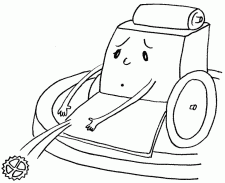
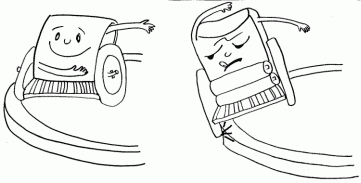
Not Out
Starting to fall or breaking the plane of the ring isn't considered out. Some portion of the robot must actually touch outside the ring.
Contestant Stoppage
At any time after the five-second starting countdown is over, a contestant may choose to enter the exterior space or otherwise signal stoppage to the referee. That contestant's robot loses the round.
If the robot is malfunctioning or in a position in which damage could occur, it might be in the contestant's interest to halt the round and take the short-term loss.
A contestant that communicates with a robot, attempts to distract (such as with an IR or laser emitter), or in any way attempts to interfere with the outcome is also considered signaling stoppage.
Stopwatch
At the referee's discretion, the referee may choose to stop a round if: * Three minutes have expired * No progress has been made in some period of time * The robots fail to touch each other for some period of time * The robots are hopelessly entangled or otherwise deadlocked * Both robots fail to start or both contestants signal stoppage At the referee's discretion, the referee may choose to end a round and choose the round winner if: * Smoke, fire, damage, or any other violation has occurred * No progress is likely to be made even if the round is restarted
End Of Round
At the end of a round, the contestants retrieve their robots and prepare them for the next round.
End Of Match
The first robot to win two rounds, wins the match.
This means there can be as few as two very quick rounds to win a match. Or there can be as many as three, three-minute rounds (not counting restarts). In the latter case, each robot must have won a round to force the third-round tiebreaker.
Of course, a match may also end if a contestant or robot is disqualified or otherwise unable to complete.
Time limits
Between the matches ther should be minimum 5 minutes break to allow exchange of batteries, replacements etc. This is to not depend on the order of contestants.
Evaluation and prices
Each registered robot after reaching the destination will be rewarded with the diploma. The winner is the robot with the highest score.Disqualification
The robot is disqualified when breaks any rule of the competition, but especially in these situations:
- dangerous behavior, safety danger,
- destroying, damaging the track,
- the robot breaks apart while moving
Limitations
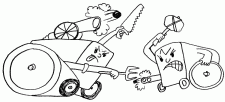 At all times, robot behavior must be non-offensive, non-destructive, and
non-harmful to humans, robots, and the facilities. This is an immutable
principle, even if the behavior is unintentional or not by design.
At all times, robot behavior must be non-offensive, non-destructive, and
non-harmful to humans, robots, and the facilities. This is an immutable
principle, even if the behavior is unintentional or not by design.
During inspection (and at any time during the event), the judges may require safety changes or other modifications to meet the harmlessness requirement. Harmful robots are either not allowed to compete at all or are later disqualified if potential harmful issues are proven or revealed in battle.
Judges also examine to see if a robot's design is sufficient to survive the expected pushing, shoving, and physical rigors of competition. Suggestions may be made to avoid damage to the robot. A weak robot is usually allowed to compete at its own risk.
During the contest, the judge must determine if a robot's failure was due to its own lack of durability. Failures due to exposed wires or unsecured or flimsy parts shall be the responsibility of the robot with such weaknesses.
 At all times, Sumo Robots must not emit smoke or fire, leak, stain, or soil,
disperse powder, grit, or grime, spray, throw, or use projectiles, jam, shock,
or electromagnetically interfere etc.
At all times, Sumo Robots must not emit smoke or fire, leak, stain, or soil,
disperse powder, grit, or grime, spray, throw, or use projectiles, jam, shock,
or electromagnetically interfere etc.
However, as for the last point, naturally some damage occurs from scoops, changes in starting orientation, and from the battles themselves. This is expected and acceptable to any reasonable extent.
Sumo Robots must not fly or generate lift to isolate themselves from the ring surface. The "no-fly" rule isn't intended to prevent a robot from having a floating portion (such as a camera, sensor, flag, or distraction) nor to prevent jumping or other interesting behavior. The robot qualifies as long as a major portion of the robot is generally available to be pushed out by the opponent robot.
Suction, Magnets, and Sticky Wheels
The suction, glue, "sticky wheels", magnets, or other methods of increasing downward force should apply following method of determining a violation: to place the robot on a piece of paper and lift up the robot to see if the paper lifts too.
And, of course, all the common rules apply.
The rules above are based mainly on the Josef Szylar's rules (www.robozor.cz) and David Cook's one (www.robotsumo.com). Thanks for illustrations goes to Michaela Szylarova.

